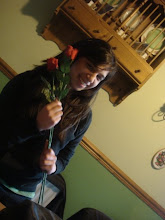In what ways does your media product use, develop or challenge forms and conventions of real media products? Our film’s opening sequence conforms to the forms and conventions of both real film opening sequences as well as genre specific conventions of thriller/horror films through its simple yet enigmatic narrative, action codes and the overall slow paced editing style.
It begins by establishing the setting with an LS like many real film openings such as
Cleaner (Renny Harlin, 2007), for example. It then goes on to introducing the main female character through a cut up montage of shots of her getting ready.
Legally Blonde (Robert Luketic, 2001)-Our broken up montage sequence very much compares to the ‘
Legally Blonde’ opening which also uses cross cutting between the girl getting ready indoors, and her cycling outdoo

rs.
-We do not see her face and likewise, Laura’s face is not revealed until the near end.
Here we have used theorist Roland Bathes’ idea of the enigma code, where details of the story are held back in order to increase the effect of the final revelation. It also helps to build up suspense and captivates the audiences’ interests who maybe suspicious as to who she is.
Propps TheoryBeing a thriller/horror, each of her shots signifies that she may be the victim or according to Propp’s theory the ‘princess’ character involved, who being home alone, needs protection from the villain, especially due to the sexually exposing shower shots which have been used in many thrillers since
Psycho(Hitchcock, 1960). We challenged this genre convention by revealing the conventionally victimised female character to in fact be the villain or so called ‘psycho’ of our film, introducing a great twist to the story through this unconventional role reversal.
The themes of the film however remain conventional to the genre of thriller/horror films including:
-Revenge- wants to kill her boyfriend
-Psychiatric behaviour – Evident in the diologue ‘you’re two minutes late’
-Isolation -within the ordinary but empty house, a typical setting for a thriller
-Entrapment- Dark and enclosed areas of the house, feeling of entrapment is created through tight CUs of Laura as she gets ready which makes it feel like there isn't much space around her.
To make it look like more of an opening sequence rather than a trailer montage we:
 - incorporated cross cutting between the two characters
- incorporated cross cutting between the two characters
- presented a parallel narrative
- used the idea of ellipses within the storyline for example in one shot she drops her towel and in the next she is tying her dress. Here we can assume that there was time in between where she put her dress on.
- We also incorporated a phone conversation indicating the continuation of the story line
Some of the more obvious elements that conform to real film openings include the use of:
- Credits maintained throughout the sequence introducing the cast and crew
- The production company name ‘Perspective Productions’ is conventionally mentioned at the beginning.
- An enigmatic title at the end in a sophisticated font to suit the style of the opening sequence
- Abandoned- the calm and mysterious soundtrack composed by Robert Davis- plays throughout the opening and fades away towards the end slowly taking the audience into the core of the film.
From the opening sequence it is evident that our film breaks the conventions of Todorov’s classic narrative pattern as it begins with disruption rather than equilibrium, which we see when the female picks up the knife within the first two minutes of the film’. Audience feedback shows that this has a lot of dramatic impact on our sequence and leaves them wanting to watch the rest of the film, and this is a function of an opening sequence.
Iconography
Our opening sequence also establishes the core iconography set around the house through the consistently red mis-en-scene, which is very specific to thriller/horror films.
Red Connotes: danger, blood, murder, love, romance
The idea of using red as a theme in our sequence (red roses, lipstick, candles etc.) was also inspired by Legally Blonde (Robert Luketic, 2001) where pink is a prominent colour throughout the film. It was also inspired by the classic horror Don’t Look Now (Nicolas Roeg, 1973) where the colour itself adds a lot of impact in making the film more dramatic and gory.

The title ‘Love you to Death’ is also in red sophisticated font anchoring the two main themes of love and danger. It looks like it has been stained in blood connoting death.
The low-key lighting in our indoor shots creates a very sinister mood and contrasts with the bright outdoors contrasts with the indoors indicating the use of binary opposites, a concept identified in many films by theorist Levi Strauss. It suggests that the victim, Barney, is walking from light or safety, to the dangers of darkness. Here we have also used pathetic fallacy as the weather seems to get worse as Barney comes closer to his own death.
The knife at the end is probably the greatest genre signifier featured in many horror films such as Halloween (John Carpenter, 1978), and Psycho, suggesting violence, and as an opening sequence should, it establishes audience expectations for the rest of the film.








 - incorporated cross cutting between the two characters
- incorporated cross cutting between the two characters

